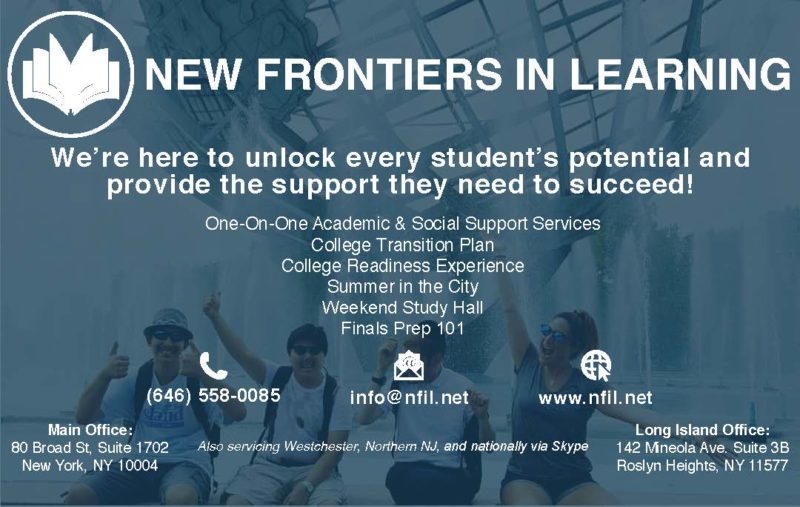Self-advocacy is the ability of an individual to speak on behalf of oneself, and is a critical skill to acquire when it comes to moving towards independence. Self-advocacy includes the quest for finding information, the process of making decisions, seeking help in times of need, understanding one’s rights and responsibilities, problem solving as issues arise, and the ability to broadly incorporate these skills as necessary. As important as advocating for oneself is, it can be a challenging skill for individuals to develop naturally, and especially for those diagnosed on the autism spectrum.


Samantha Feinman, MSEd, TSSH

Casey Schmalacker, BA
Self-advocacy skills begin to develop at a very early age and continue to mature through adolescence and young adulthood, setting individuals up to have the ability to think and make decisions for themselves as they become less dependent on others. Individuals diagnosed on the autism spectrum, however, may have a difficult time developing such skills through general life experiences. Self-advocacy skills are made up of several different characteristics and skill sets, including self-awareness and understanding one’s rights, communication skills, the use of executive functioning, and one’s ability to generalize in novel situations. Such skill deficits, especially those in the area of communication, can act as a barrier to students on the autism spectrum (Adreon & Durocher, 2007). In order to proactively set up individuals for success through high school, college, and beyond, it is necessary to teach self-advocacy skills explicitly during adolescence.
Why Is Teaching Self-Advocacy Important?
There are many changes occurring during the adolescent years that require the development of self-advocacy skills. Further, once students reach the college and postsecondary environment, they are fully responsible for utilizing their self-advocacy skills to seek out the office of disability services on campus, disclose and provide documentation of their disability, and request specifically the testing and environmental accommodations they need. The same holds true for the career and employment environment as well. Because there is often a shift during middle school and a student’s teenage years in which adolescents become more resistant to parental support, adolescence is a perfect opportunity to begin the move from parents having the primary role as advocate for the child to guiding and shifting the responsibility to the students themselves. By using this drive of the adolescent to move towards independence as a teachable moment, it allows the parent, teacher, and/or coach to model for the student the types of support they have been utilizing with the goals of transitioning the ownership to the student. This is especially relevant to students diagnosed on the autism spectrum, as research has demonstrated that individuals diagnosed with autism spectrum disorders (ASD) may recall their own experiences less confidently than the experiences of others that they observe (Lind, William, Bowler, Peel, & Raber, 2014).
An emphasis on teaching and coaching a student to self-advocate should be a focus as early as adolescence so that students have time to develop a thorough understanding of who they are as a learner and what they need to help them learn most efficiently. Further, students need to debrief help-seeking scenarios in order to accurately identify situations in which they have the right and responsibility to ask for help, where to receive it, and how to follow through with putting it in place. Studies have demonstrated that when students learn from their parents and others, such as their teachers and peers, how to self-advocate early in life through role modeling, they are more likely to utilize those skills before and during their college years (Kimball, et. al, 2016).
What Self-Advocacy Skills Need to Be Taught?
According to a model of self-advocacy as defined by Daly-Cano, Vaccaro, and Newman (2015), students with various learning differences, including ASD, can be taught to utilize self-advocacy skills proactively, reactively and retrospectively. The proactive view of self-advocacy teaches a student to seek out supports to be put in place prior to actually needing them. One example of proactive self-advocacy is when a student demonstrates that he/she is eligible to receive extended time on an exam prior to needing it and receives and schedules the accommodation. Rather than setting up accommodations for students in middle school and high school, and for standardized tests such as the ACTs or SATs, students should be encouraged to be a part of the process. This can be practiced to obtain such accommodations for when it becomes their responsibility. Reactive self-advocacy occurs when a student seeks out help after facing a specific challenge. For instance, if a student for some reason is not offered the accommodations they are eligible for and do poorly on an exam, they will need to advocate for themselves the next time the opportunity arises. Retroactive self-advocacy occurs when a student advocates for support after they recognize they have not done well and need support moving forward. In both of these examples, this is where teaching and modeling self-awareness, communication skills, and executive functioning become essential.
Here is the breakdown of skills needed in order to advocate from beginning to end to understand the whole process:
Self-Awareness: In order to self-advocate, it is essential to have a clear understanding of one’s self and past experiences, current or upcoming situations, and potential solutions to the situations at hand. This includes:
- Understanding one’s relative strengths and weaknesses
- Being able to identify when a problem is faced and recognize if the problem can be solved on one’s own using a previously successful problem solving method or whether help is needed to solve the problem
- Identifying available resources and individuals who can assist with the problem
Communication: Once an individual recognizes that they need help, they have to be able to communicate their needs to others. Whether it is a co-worker, professor, or other professionals, individuals need to explain what they are struggling with and what help they are searching for. It is also essential to ask any questions to clarify what the next steps are to solving a problem. This includes:
- Reaching out and setting up a time for individuals to assist with the obstacle
- Communicating any confusion on the support offered and asking more questions when confused
- Communicating if certain follow up steps seem difficult to manage without further support
Executive Functioning Skills: Even when students have a plan of action to address current and future problems, the implementation of these plans can be difficult. Executive functioning skills and systems are important to ensure that plans are executed effectively. Creating clear plans can support individuals through the initiation and follow through process. Skills include:
- Ensuring a follow up plan is scaffolded in order to establish a platform for success
- Clearly mapping out next steps for follow up
- Checking in to make sure strategies are working and adjust when they are not
Self-Monitoring and Generalization: Once complete, it is important for individuals to reflect on whether or not their attempts at solving a problem were effective. If they were not, individuals must remember to utilize a different strategy in the future or alter the strategy to try and address the problem. If the strategy was helpful, individuals need to be aware of why it helped so that they can generalize that strategy to similar situations in the future. This includes:
- Understanding how support can be used in novel situations
- Assessing effectiveness of strategies
- Remembering successful strategies for future use
The teaching and modeling of self-advocacy for individuals diagnosed with ASD should be incorporated as an essential piece of the learning and development process during adolescence. These skills should be developed well before individuals reach the postsecondary or employment environments. Strong self-advocacy skills lead to greater confidence and success in young adulthood and beyond. Self-advocacy takes time to develop; therefore, in order to understand the intricacies of how it is utilized, adolescence is a critical period for its development.
Casey Schmalacker, Long Island Coordinator, and Samantha Feinman, Director, New Frontiers in Learning, can be reached at info@nfil.net. For more information, visit www.nfil.net.
References
Adreon, D., & Durocher, J.S. (2007). Evaluating the college transition needs of individuals with high-functioning autism spectrum disorders. Intervention in School and Clinic, 42(5), 271-279.
Daly-Cano, M., Vaccaro, A., & Newman, B. (2015). College student narratives about learning and using self-advocacy skills. Journal of Postsecondary Education and Disability, 28(2), 213-227.
Kimball, E.W., Troiano, P.F., Moore, A., Vaccaro, A., & Newman, B.M. (2016). College students with disabilities redefine activism: Self-advocacy storytelling, and collective action. Journal of Diversity in Higher Education, 9(3), 245-260.
Lind, S. E., Williams, D. M., Bowler, D. M., Peel, A., & Raber, J. (2014). Episodic memory and episodic future thinking impairments in high-functioning autism spectrum disorder: An underlying difficulty with scene construction or self-projection? Neuropsychology, 28(1), 55–67





